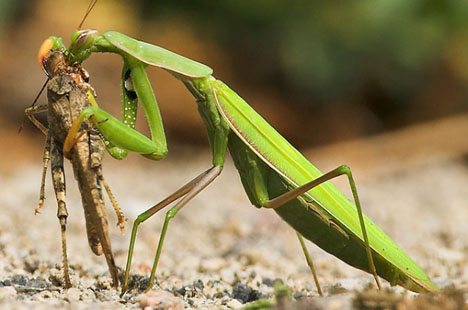Sexual Cannibalism
Biology 342 Fall 2015
Mary Cho and Sydney LaStella
Adaptive Value
Sexual cannibalism is a rare phenomenon even in generally cannibalistic populations because it is usually more costly than beneficial. The benefits of sexual cannibalism differ between the males and females of a species, and between species in general.
The 3 Theories of Sexual Cannibalism:
Female induced sexual cannibalism is largely hypothesized to occur for three reasons:
1)Adaptive Foraging
Here, Females gauge the benefits of their suitors in terms of their own survival. Whether a male would function better as a meal or as a mate is decided based on prey availability in combination with what a female may need from a male, or what each male brings to the table. Female health and success ensures the success of their immediate offspring and future generations.
2) Aggressive Spillover
Factors have the potential to effect aggressivness which are not a product of a female's environment or potential mate. Overarching behavioral syndromes passed down gentetically with potential facets of aggressiveness may result in cannibalistic behavior. Behaviors such as these may not be beneficial to a species.
3) Mate Choice
Through mate choice, females express their mate preferences. If a female needs a suitor but is not pleased with those presented to her, she may partake in cannibalistic behavior. The mate choice theory differs from that of adaptive foraging because the female's immediate health does not play a role here. The act of choosing to mate with superior males for paternal benefits, increased genetic diversity among offspring, or for other genetic benefits results in heightened health of future generations.
These three theories may not be mutually exclusive. Often, experimental results on species of cannibalistic spider support multiple.There are further adaptive value hypotheses that discuss cannibalism in terms of egg health and offspring development. Multiple studies found that the mass of egg cases and number offspring which emerge and survive increase in the offspring of cannibalistic females. These studies theorize that perhaps a performance benefit is gained through male consumption since hatching success is indeed heightened. Somehow, the female body is stimulated through male consumption, though the exact mechanism through which this occurs is unclear, it is further discussed in the “mechanisms” section of this site.
From a Male Point of View:
In numerous sexually cannibalistic species males sacrifice their bodies to be fed on during copulation as a mating strategy for increased copulation length, therefore increasing the chances of successful insemination. Postcopulatory sexual cannibalism implies that male complicity to be killed is merely an extreme form of paternal investment, when paternal investment is not beneficial much past insemination. Further, in postcopulatory cannibalism, males should evolve to be more willing to be eaten when the expected number of male mating is low. No matter what, if sexual cannibalism means males have an increased change to inseminate a female, it increases male lifetime reproductive fitness, even if death following copulation is imminent. In postcopulatory sexual cannibalism, male allowance of cannibalism in order to support female life makes sense for the health of their offspring, but because there is no reproductive value for males to be eaten pre-copulation, adaptations must exist to ensure their reproductive success. In species where males are consumed pre-copulation, there exists selective pressure on males to evolve counter-adaptations to avoid being eaten. Some of these include the learned behavior of approaching females at times of day where predation risk is lowest or learning to recognize and avoid more threatening females. Many male spiders bind females in silk prior to copulation, and others evolved to be able to hold the female’s mouth open during copulation.
